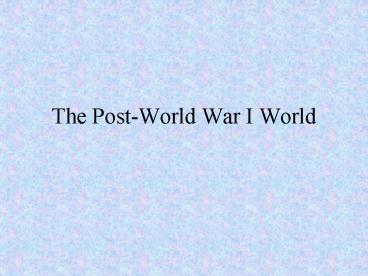The PostWorld War I World - PowerPoint PPT Presentation
1 / 13
Title:
The PostWorld War I World
Description:
World War I showed Europeans the brutal realities of industrial life. ... Many people began to disbelieve in the idea of consistent human progress. ... – PowerPoint PPT presentation
Number of Views:37
Avg rating:3.0/5.0
Title: The PostWorld War I World
1
The Post-World War I World
2
Effects of the WWI on Cultural Life
- World War I showed Europeans the brutal realities
of industrial life. - These realities can be seen in Hemingways A
Farewell to Arms and Remarques All Quiet on the
Western Front. - Many people began to disbelieve in the idea of
consistent human progress.
3
Developments in Physics and Psychology
- 1905-Theory of Relativity-Albert Einstein.
- 1890-Psychological explanations of mental
illness/Psychoanalysis -Sigmund Freud.
4
Art
- Paintings no longer depicted recognizable
objects. - Beauty and emotion was expressed in color and
shape. - Expressionists, cubists, abstractionists,
dadaists and surrealists. - Degas, Gauguin and Picasso all experimented using
ideas from Asia, Pacific and Africa
5
Causes of the Great Depression
- WWI created many economic problems throughout
Europe. - Glut of raw materials that led to lower prices.
- Overproduction of agriculture-War-time levels of
production which led to depressed prices. - The depression in the USA was also caused by
speculation. - Oct. 24, 1929-Black Thursday.
Germany and Austria relied on loans to pay war
reparations
British and French governments relied on war
reparations to pay off loans to the USA taken
during WWI.
1928-US lenders began to recall European loans
which placed a tremendous strain on the world
economy.
6
Effects of The Great Depression
- Effects were cyclical
- Every industrial society saw its economy shrivel.
- Decreases in business activity, wages and
employment led to decreases in demand. - The collapse of the US economy led to the
collapse of the German economy. - The collapse of the German economy led to the
collapse of the rest of the economies throughout
Western Europe. - The collapse of the industrialized worlds
economies led to collapse of the economies around
the world. - Rise in economic nationalism. International
cooperation broke down and every country was out
for herself.
7
Government Reactions to the Global Depression of
1929
- Married women in some countries like Great
Britain were barred from working. - John Maynard Keynes-Most noted economist of the
20th century. The General Theory of Employment,
Interest, and Money-He believed that government
had to intervene by increasing the money supply. - New Deal
- WWII finally brought an end to the Great
Depression.
8
Rise of Communism in Russia
- 1917-Russia pulls out of WWI as a result of civil
war (1918-1920). - Reds (Bolsheviks) vs. Whites
- Lenin and Bolsheviks take over and begin to
create a communist state in Russia. - Crushed all opposition including assassinating
the Tsar and his family. - The government took control of all privately held
commercial property. - The peasants refused to harvest crops when the
government took their crops to feed the workers
in the city. - 1921-New Economic Program (NEP)
- 1924 Lenin dies and does not see the end of the
NEP
9
Russia and Joseph Stalin
- Stalin vs. Trotsky-Stalin took power in 1928.
- Believed in socialism in one country as opposed
to a world-wide revolution - 1st Five Year Plan-Replaced NEP-Goal was for
rapid economic development. - Emphasized heavy industry.
- Collectivization of Agriculture
- Kulaks-Wealthy Peasants
- Transform the USSR from a predominantly
agricultural country to a leading industrial
power.
- The Great Purge-Anyone against Stalin was sent
to a labor camp or executed.
10
Fascism
- Developed as a reaction to liberal democracy and
the spread of socialism and communism. It is the
opposite of communism. - Attractive to Middle Class and rural populations
- Political and economic frustration lead to the
rise of fascism. - Extreme Nationalism
- Importance of the state.
11
Fascism in Italy
- Fascism rose in popularity after the WWI.
- Wide-spread disillusionment, bad political
leadership, economic turmoil, social discontent,
fear of socialism and unhappiness at the outcome
of WWI. - Led by Benito Mussolini who was a former
socialist. - His group was known as the Black Shirts.
- March 28, 1922-Mussolinis March on Rome and the
fascists took power. - 1925-1931-Il Duce consolidated his power into a
one man dictatorship. - May 1939-10 Year Pact of Steel signed.
Berlin-Rome Axis - 1938-Italian Fascism suddenly became
anti-semitic.
12
Fascism in Germany
- Nazi-National Socialist German Workers Party
- Headed by Adolf Hitler
- 1923-Attempted overthrow of Weimar Republic and
failed - Hitler jailed and wrote Mein Kampf
- Racial doctrines-anti-semitism
- 1929-National socialism gained popularity.
- Attracted disillusion people
- Frightened by idea of socialist revolution.
- Humiliated Treaty of Versailles
- 1930-1932-Nazi Party became single largest party
in parliament. Hitler is named Chancellor.
13
Nazi Policies
- Replaced federal structure with a centralized
state. - Created a race-based national community. Aryans
- Urged women through national programs to give
birth to racially desirable children. - Eliminated all opposition.
- November 9-10-Kristallnacht
- Systematically destroy the Jews.
- Between 1939-1945-Systematically began destroying
all undesirable races.































